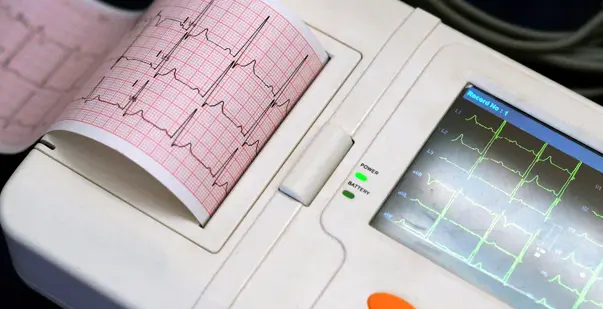Your heart is a vital organ responsible for maintaining the blood supply to your entire body. At rest, it beats around 50 to 99 times per minute. However, if it beats more than 100 times, it could be due to an underlying cause— supraventricular tachycardia!
Supraventricular tachycardia (SVT) refers to conditions characterized by episodes of rapid heartbeat. It occurs from abnormalities in the electrical activity of the heart’s upper chambers. This rapid heartbeat can block the adequate blood flow to the heart as well as to the entire body.
Read on to discover more about the complex condition!
Master ACLS Now
Get ACLS certified with confidence
Defining Supraventricular Tachycardia
Supraventricular Tachycardia, or SVT, is a medical term used to describe a variety of heart rhythm disorders that originate in the atria or ventricles. The term, derived from Latin, refers to ‘above the ventricles’ and ‘fast heart rate’. This condition results in an abnormally rapid heart rate.
Under normal circumstances, the heart pumps around 100,000 times a day to circulate oxygen and blood throughout the body. It consists of four pumping chambers. At the top of the heart is the sinoatrial node (SA), also known as the natural pacemaker, responsible for initiating the heart’s contraction and rhythm through electrical signals.
However, in cases of supraventricular tachycardia, the heartbeat accelerates due to the premature firing of these electrical signals. This premature firing causes the atria, the upper chambers of the heart, to contract prematurely, disrupting the primary electrical signal originating from the SA node. Consequently, the heartbeat increases beyond the normal rate.
Causes of Supraventricular Tachycardia
Your heart consists of four chambers. The upper two chambers are known as atria, and the lower chambers are the ventricles, which contract rhythmically to supply blood to the body. This rhythm is produced and regulated by a specialized electrical system, which includes the SA node and AV node.
Any disruption in the conduction of this electrical system can result in abnormal rhythms, known as arrhythmias. SVTs typically occur in the atria. It happens due to the reentry of electrical impulses through an alternate pathway. When these impulses reach the ventricles prematurely, they can cause premature beats.
Several common triggers for SVT include:
- Previous or current medical history of heart diseases, such as
- heart attack,
- rheumatic heart disease,
- mitral valve prolapse,
- heart failure, or
- pericarditis.
- Chronic lung disease.
- Excessive intake of caffeine or alcohol.
- Certain medications, including asthma and allergy drugs.
- Long-standing diabetes mellitus and hypertension.
- Anxiety disorders.
- Strenuous exercise.
Symptoms of Supraventricular Tachycardia
When you experience any of the following symptoms, it’s important to consult a physician:
- Rapid heartbeat for several minutes
- Palpitations
- Weakness and tiredness
- Dizziness
- Shortness of breath and sweating
- Fatigue
- Chest pain
Read More: Treating Narrow Complex Tachycardia: A Clinical Guide
Types of Supraventricular Tachycardia
Three types of tachycardia fall within the category of SVT ACLS.
-
Atrioventricular nodal reentrant tachycardia (AVNRT)
In AVNRT, the abnormal short circuit occurs near the AV node. Instead of a single AV node lying between the top and bottom chambers, there will be a second connection. This abnormal connection is usually present since birth.
Women are twice as likely to experience AVNRT compared to men. This is because the arrhythmia is connected to an imbalance in sex hormones, which typically occurs during the luteal phase of the menstrual cycle.
-
Atrioventricular reciprocating tachycardia (AVRT)
This type of abnormal circulatory condition combines the AV node with an accessory pathway connecting the atria and ventricles. Reports indicate that two-thirds of children with SVT have AVRT conditions. It is a form of pediatric arrhythmia and is slightly more common in males.
-
Atrial Tachycardia (AT)
AT (Atrial Tachycardia) is the least common form of supraventricular tachycardia. In this condition, the electrical impulse originates extra abnormally from a small area in the atria, apart from the SA node. Chronic AT is frequently observed in adults with congenital heart disease.
Read More: SVT with Aberrancy or Ventricular Tachycardia
Diagnosis of Supraventricular Tachycardia
The diagnosis for ACLS SVT is planned with two forms of diagnostic procedure. It includes a physical examination and a series of laboratory tests.
Physical Examination
Your healthcare professional can diagnose unstable SVT through a comprehensive physical exam. During the examination, your doctor will try to determine what is triggering the abnormally fast heart rate. You might have to answer the following questions:
- When you first experienced the symptoms.
- How your symptoms begin (e.g., in the morning or during exercise).
- Whether you notice any connection between the use of caffeine or any other regular habit and your symptoms.
- Whether your symptoms appear slowly or suddenly.
- How long do the symptoms tend to last?
- Whether any family members have heart problems or have undergone related procedures.
After the consultation, your healthcare professional might:
- Measure your blood pressure.
- Palpate your thyroid gland.
- Take your temperature.
- Collect a blood sample.
Tests
After discussing your symptoms, if necessary, your physician might prescribe the following tests:
- ECG or EKG: An Electrocardiogram allows you to record your heart rhythm over time and detect any anomalies. Diagnosis of unstable supraventricular tachycardia involves six electrodes. It will be placed on your chest, arms and legs. You have to breathe normally and lie still during the test.
- Electrophysiology study: It helps in analyzing the electrical signals in your heart. The study also determined how the signal was transmitted through each section, even in sedation.
- X-ray: A chest X-ray reveals the health status of your lungs as well as the size and structure of your heart’s chambers. It can help identify conditions such as pneumonia or a collapsed lung, which could predispose you to SVT.
- Cardiac enzymes: Blood tests can detect increased levels of specific proteins or enzymes found in cardiac muscle.
- Holter monitor: This compact portable device records your heart activity for 24-48 hours. You attach electrodes to your chest and carry out your daily activities. Remember to remove it before showering or bathing.
- Event monitor: Another type of portable ECG device that can be used for days or weeks, depending on the duration of symptoms.
Risk factors of Supraventricular Tachycardia
When it comes to supraventricular tachycardia ACLS, the condition is found in infants, children, and even young adults. Some factors that contribute to the risk of SVT include:
- Age: supraventricular tachycardia is common in both children and middle-aged people. In short, the condition can affect individuals of all ages.
- Thyroid disorders: If you have an overactive or underactive thyroid gland or a thyroid disorder, it can increase the risk of SVT.
- Sleep apnea: Obstructive sleep apnea is defined as interrupted breathing while asleep. This condition can also increase the risk of supraventricular tachycardia.
- Drugs: a medical history of substance abuse or illegal drugs (cocaine or amphetamines) can also induce an SVT episode.
Treatment for Supraventricular Tachycardia
People with no symptoms of supraventricular tachycardia may not need treatment. In most infants, the episodes usually stop on their own. However, if you experience consistent symptoms, then the SVT treatment ACLS includes the following.
Non-surgical Treatments
In the first phase, you will be prescribed for non-surgical treatments such as
- Lifestyle changes
Incorporating certain lifestyle changes may reduce the risk factor for SVT ACLS. These include:
- Control your stress
- Manage diabetes and high blood pressure
- Consume low-fat, low-salt, and low-cholesterol foods
- Lose weight if you are obese
- Exercise regularly
- Learn to count your pulses (Which should be 50-100 per minute)
- Avoid smoking and drinking alcohol or caffeine
- Maintain consistent follow-up care
- Take medication on time
- Vagal maneuvers: Older children with supraventricular tachycardia can learn vagal maneuvers. It will assist you to slow or stop an episode of fast heart rate. These may include:
- Holding breath and bearing down
- Immersing the face in ice-cold water
- Coughing
- Medications: your doctor might also prescribe certain medications to prevent the episodes.
- Carotid sinus massage: In this treatment, your doctor will apply gentle pressure where the carotid artery splits into two branches in the neck. This helps your body release chemicals that slow down the heartbeat.
Surgical Procedures
Surgical procedures that help in treating supraventricular tachycardia include
- Catheter ablation: It involves removing the extra electrical pathway or cells responsible for fast heart rate. A thin, flexible tube called a catheter is inserted through the veins or arteries. Sensors on the catheter might cause small scars in the heart.
- Cardioversion: It is a medical procedure to control an abnormally fast heart rate. It helps restore a normal heart rhythm using electrolysis. During the procedure, electrodes are placed on the chest to send electric shocks to the heart. This alters the electrical signals of the heart and restores a regular heartbeat.
- Pacemaker: A pacemaker is a small implantable device that stimulates the heart to beat at a regular rate. It is implanted inside the skin beside the collarbone using minor surgery.
Conclusion
SVT, a rare, life-threatening condition, can cause significant symptoms. Most people have supraventricular tachycardia, yet they live completely normal lives and have an average life expectancy. In normal cases, it is curable and may not lead to any potential health conditions. However, it is vital to consult your cardiologist to ensure a healthy lifestyle and avoid any complications.







